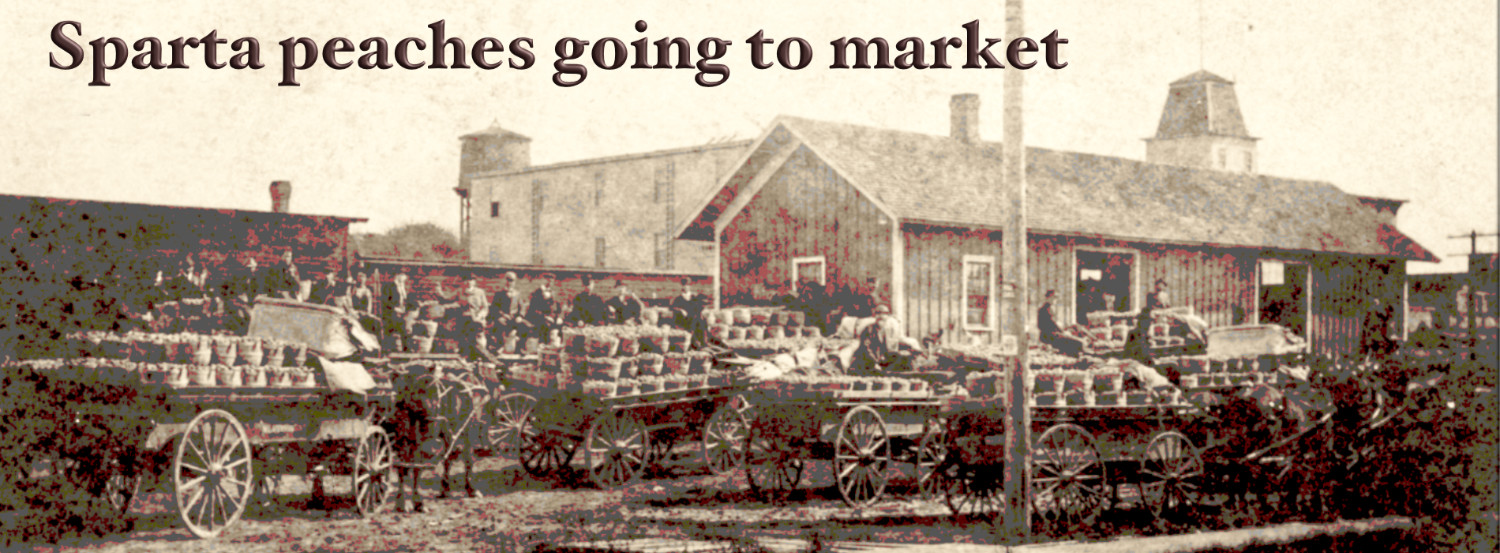

Pioneering
Agriculturalists
Agriculture put Sparta on the map. From early on, its picturesque orchards scattered over gently rolling hills dotted with charming farms produced an abundance of apples, peaches, pears, and cherries. As soon as the homesteads were built, orchards were planted. It didn't take early pioneer farmers long to realize their rich soil and favorable weather patterns were ideal for growing bountiful orchards, raising beef, pork, chicken, dairy, and a wide variety of other crops. In fact, that's what drew many of the early settlers to select Sparta Township for their new homes.
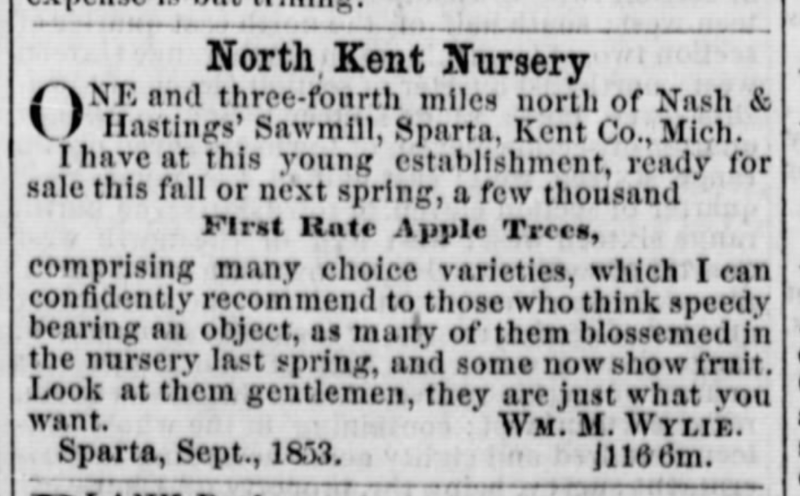
W.M. Wylie's advertisement published in the 3 Jan 1855 edition of the Grand River Times at Grand Haven, Michigan
By 1853, William Mosley Wylie had established North Kent Nursery on the north end of Sparta and was advertising apple trees. He was born on 2 Apr 1824 at Lebanon, Madison County, New York and arrived at Sparta in November 1845 with his brothers, Henry and Edward. These early settlers explored and chose 320 acres in Sections 3 and 10, jointly, which they purchased in January. Edward began clearing the lands while William and Henry traveled back to New York. Before long, they returned with Henry's wife and children.
William married Elizabeth Mills, daughter of Solomon Parker and Abigail (Danforth) Mills, on 28 Sep 1853 at Sparta. In 1860, they lived on an 80 acre farm. During the Civil War, William was included on a list of men subject to do military duty dated June-July 1863, with a notation stating his "wife died a short time ago, left 5 small children, oldest 8 years old." Whether or not he was called to service is unknown. On 30 Oct 1868, Ermina Ellis became William's wife and they had five additional children.
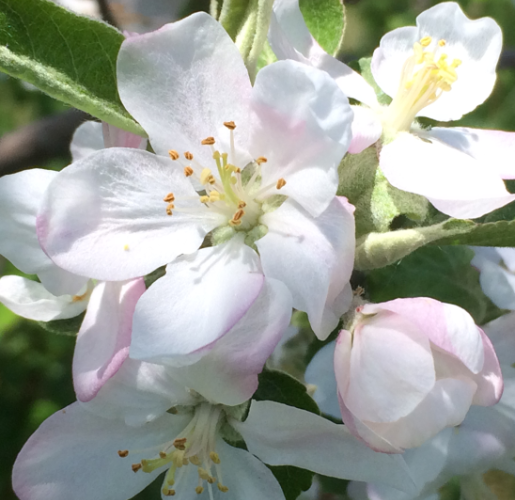
Apple blossoms
The first Federal Agriculture Census to include orchard crops was conducted on 1 Sep 1880, but it only requested details for apples and peaches. The records showed nearly every rural Sparta Township landowner had at least six apple trees and as many as 350-375 "bearing trees", as in the case of Rev. Erastus Norton and Hiram Myers, respectively, whose orchards had each produced 1,000 bushels of apples the previous year. Brothers Ephraim and Perry Bradford had 300 trees combined resulting in 850 bushels, from just seven acres of land in total. Both Carey Buck and the Bloomer brothers, Reuben and Coles Abel, harvested 800 bushels of apples at their farms, while 600 bushels were picked at John Simons' farm, and Gilbert Bettes brought in 400 bushels of apples from 350 trees on six acres.
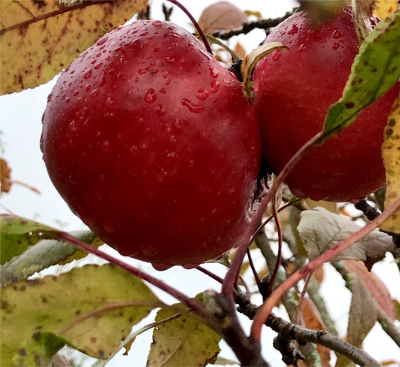
Late season apples
Lyman S. Ballard collected 100 bushels of apples from 300 trees he planted on five acres. Dozens of farms had at least 100 apple trees which yielded fruit in their orchards. Many others had planted orchards but their trees were not yet able to produce fruit. Old fashioned apple trees, grown from seed, may take between ten and twenty years to become mature before they bear fruit.
Rev. Erastus Norton's apple orchard covered fourteen acres, the largest in Sparta Township at the time, while Jonathan Nash had planted just one-half of an acre with at least thirty-five trees and they produced 200 bushels of apples. Mr. Nash also dedicated another half-acre of land to growing peaches with 100 trees which brought forth ten bushels of the golden fruit.
The Bloomer Brothers
Among the first who ventured into growing peaches on a far larger scale were the Bloomer brothers who planted a 25 acre orchard and reported 2,800 "bearing trees" from which they harvested 3,000 bushels of the sweet golden bounty. Other farmers who saw the potential in raising peaches included William Anderson with 650 trees on nineteen acres from which he picked 300 bushels. Daniel Purdy and Marcene Cummings each had 200 peach trees while James Hanford planted 30 acres. All three of these farms had brought in 100 bushels of peaches, each.
Ed Swartz, a nurseryman, assisted in an 1881 report presented at a meeting and published by the State Horticultural Society on the topic of "Setting an Orchard". Mr. Schwartz had rented fifteen acres for fifteen years from the Bloomer Brothers on which he planted peaches. He provided a list of 2,800 peach tree varieties planted at a Sparta Township orchard: 600 each of Early Crawford, Barnard, and Late Crawford; 200 each of Hale's Early and Hill's Chili; 100 Early York; 75 Beatrice; and 50 each of Alexander, Foster, Jacques Rareripe, and Reeves' Favorite. In the discussion which followed at the meeting, some varieties were said to be of little value for the table while others were not good keepers, so they were difficult to ship to market and deemed better suited for home use.
After several years, peach trees were past their peak so would be replaced with new stock to maximize production. Varieties such as Hale Havens, Red Havens, Elbertas, and several others improved the size and quality of peaches as well as the growers' ability to enter larger commercial markets. Consequently, as more people came to rely on commercially produced fruit and fewer grew their own at home, many of the delicate and unique heirloom varieties fell by the wayside.
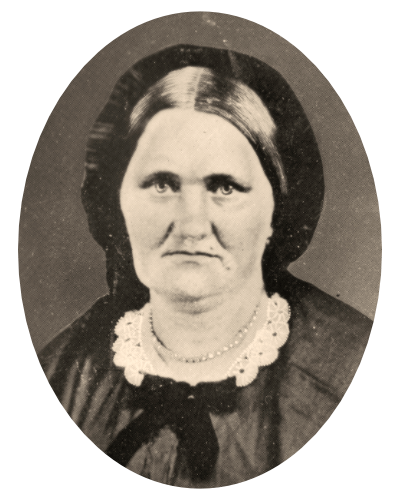
Harriet Symes, Sparta Township's first school teacher and midwife
Bachelor brothers Reuben and Coles Able Bloomer in their early 20s arrived shortly before 1875 from Huron County, Ohio, to purchase their farm. The Bloomer brothers' property compromised of 160 acres located in the northeast quarter of Section 31 plus an additional 240 acres of the north half of Section 32 in Sparta Township for a total of 400 acres in all. A large part of their purchase was sold to the Bloomers by Mrs. John Manly.
Bachelors off the market! Coles Bloomer married May Cummings in 1890 and in 1893, Reuben wed Susie Gordon. Coles bought out his brother's interests in the farm and Reuben relocated to Grand Rapids. By 1912, Coles had become a member of the Board of Directors for Sparta State Bank and he served as President.
John and Harriet Symes
John Symes planted five acres with 300 apple trees and they produced 450 bushels, as reported. Although the Symes family primarily raised cherries, the 1880 Federal Agricultural Census only sought details for apple and peach orchards at that time.
Noted as one of the earliest settlers at Sparta, John arrived in June of 1845 and settled in Section 26, at the southeast corner of what we now know as Sparta Avenue and 12 Mile Road. The Symes property ran east and south from that intersection to just north of the long-time landmark commonly known as "Potato Joe's".
John Symes had quite a journey to make his home at Sparta. Born in 1817 at Devon, England, he immigrated to the Untied States in 1836 and became a naturalized citizen while he lived in Pennsylvania. He married Harriet W. Abbott, a native of Canisteo in Steuben County, New York, and they soon migrated into Richland County, Ohio, where a son, James Abbott Symes, was born in 1840 at the town of Shelby.
Once the young family arrived at their Sparta property in 1845, they cleared some of their land to build a home from logs, about a mile and a half south of Sparta. By the following year, in addition to her own children, Harriet had accepted other students as she taught school in their home, and became the first school teacher in the Township. An energetic hard-working woman who cared about the well-being of others enough to lend a helping hand, Harriet was also the first mid-wife in the Township and she continued to deliver babies for the next thirty years. Whenever Harriet was called away from home to assist with the delivery of a new baby, John would step in and serve in the capacity of a substitute teacher. As a young man, their son James taught school as well.
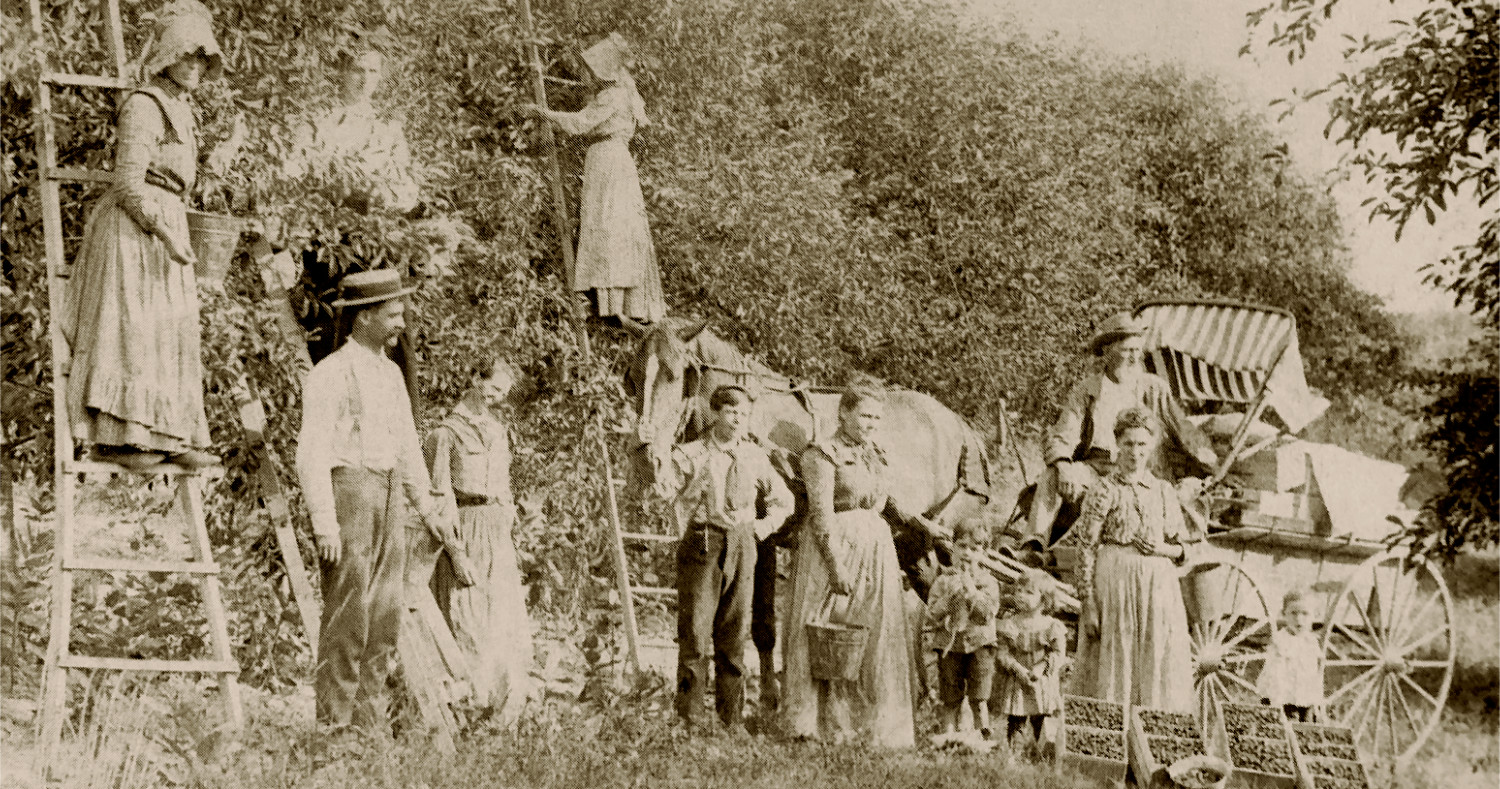
Harvesting a bountiful cherry crop at the Symes family's Cherry Hill Farm orchard with James standing and John seated in the buggy. How many people do you see... 10... 11... or more? Photograph was taken at about 1882-1885, from the Sparta Township Historical Commission collection
Lyman and Lucina Ballard
Elinor Mariah Ballard, whose nickname was "Nellie", was born in 1843 at Port Byron, Cayuga County, New York. Her mother passed away and her father remarried. In the 1860 Federal Census, she was recorded as "Ellen" in the household of her first cousin, Lyman S. Ballard, at Sparta.
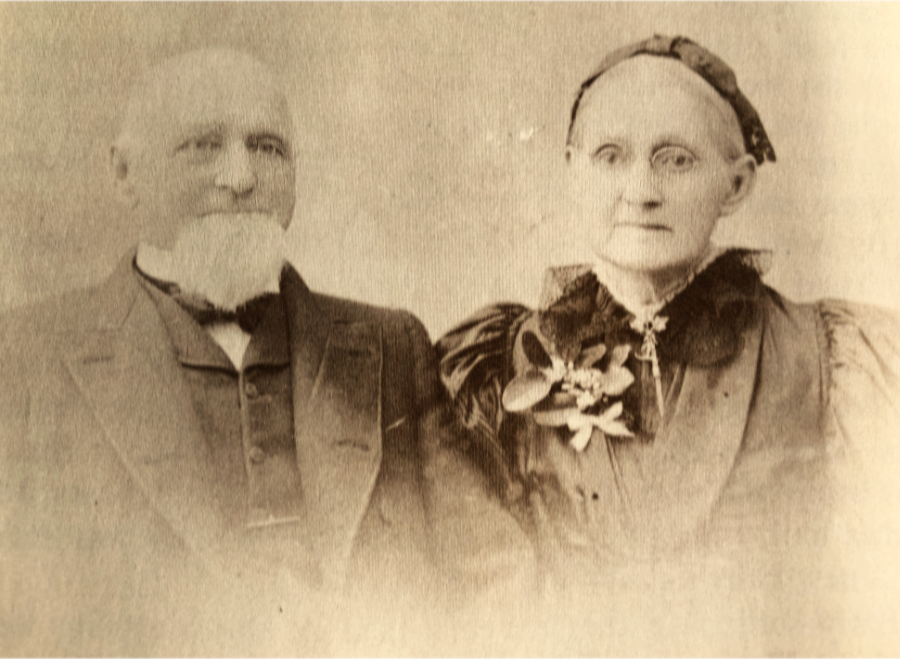
Lyman and Lucina Ballard
Born in 1817 at Montgomery, in Orange County, New York, Lyman arrived with his family and two brothers at Sparta Township in 1850 where he purchased land in Section 34 to establish a farm. As roads were developed and named, this location eventually was identified as the intersection of Ten Mile Road and Sparta Avenue. The early settlement of Ballards Corners sprung up at the crossroads as other people made their homes in the area. Mr. Ballard operated a general store then was appointed Postmaster on 28 Feb 1856 for South Sparta, and on July 29th for Englishville. Civically minded, he was an inspiring and driving force in the establishment of Ballards School on one of the corners of the little hamlet. Lyman and his wife, Lucina (Nash) Ballard, donated land on another corner for Ballards Church and became charter members of the congregation.
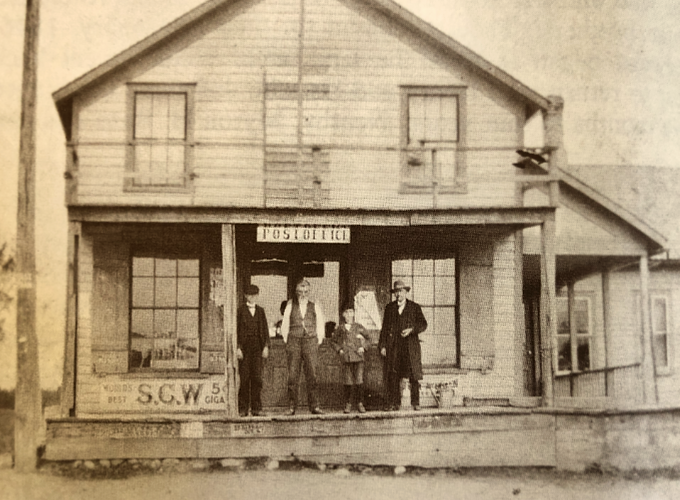
Postmaster Lyman S. Ballards at his Ballards Corners general store
In 1863, James Symes married Elinor Ballard, and the newlyweds began their family. They were blessed with four daughters and a son. Their first daughter, Harriet Mae, died as an infant but Lula, Laura, J. Ballard, and Emma survived into adulthood.
Orchards Report
The Michigan State Horticultural Society published reports detailing the productivity of area orchards in 1880 and 1900 as they compared the number of acres to the bushels of fruit produced.
1880
Apples - 586 acres for 7,233 bushels
Peaches - 58 acres for 2,839 bushels
Cherries, Currants, Plums, and Berries - 9,579 lbs./304 bushels
1900
Apples - 519 acres for 15,163 bushels
Peaches - 369 acres for 19,316 bushels
Pears - 26 acres for 1,983 bushels
Plums - 103 acres for 4,246 bushels
Cherries - 27 acres for 1,354 bushels
66,000 Bushels of Peaches
Once upon a time, peaches were the top produce crop at Sparta. From farms mostly perched upon 'the Ridge' west of town where the sweet golden fruit grew, until their transport to market by train, the peach harvest involved the effort of many.
Two such men, each successful in business in his own right, Charles C. Darling and Albert H. Meeker, saw opportunity as they paired up for a new endeavor. Darling's store offered groceries and footwear. Meeker operated an apple drying business. Their joint venture was a 'fruit commission house'. Meeker & Darling secured contracts with local produce farmers to sell their crops in expanded markets by consignment. Once the commodity arrived by train, its value would be determined and the buyer's payment issued to the farmers. Until actual cash was received, they didn't know how much it would be, but were legally obligated to accept the valuation. It was standard practice in the day.
Albert H. Meeker
Albert, Al, or A.H. as he was often called, was born in 1852 at Sparta to pioneer residents, Allen and Electa M. (Hilton) Meeker. The boy learned the trade of agricultural pursuits as he grew up on his father's 160 acre farm—located at what is now the southeast corner of Fruit Ridge and Twelve Mile Road. Albert received a public education at Sparta Township and Lisbon schools.
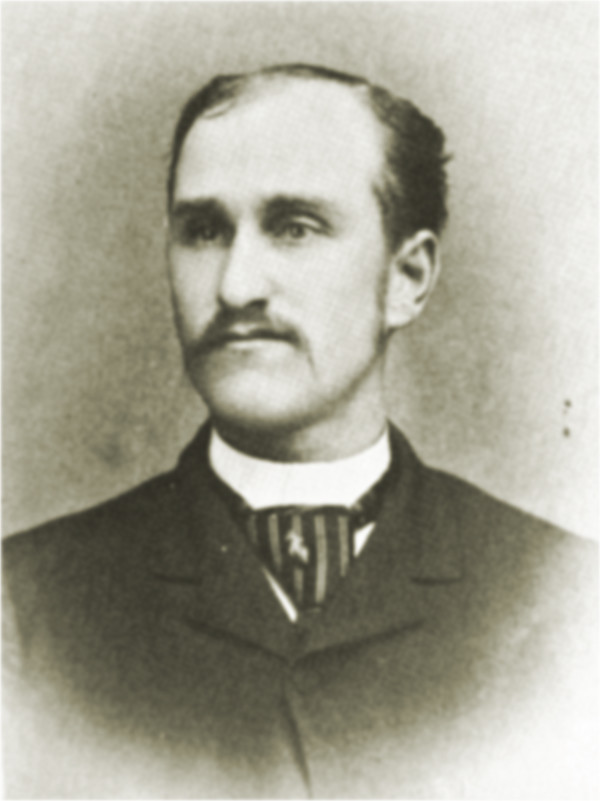
Albert H. Meeker
As a young man, Al desired the life of a merchant and became the proprietor of a meat market at Lisbon. "Subsequently, he entered the hoop mill at Sparta and for a time was engaged in sawing hoops," per his biographical sketch in the Grand Rapids and Kent County, Michigan: Historical Account of Their Progress by Ernest B. Fisher (1918). In 1883, Albert was in partnership with Charles M. Shearer for the manufacture of hoops under the moniker of Shearer & Meeker.
But Al returned to the farm, tilling the soil for another three years. "The call of the village and its business operations, however, proved too strong, and when he again left the parental roof it was to locate at Sparta, where he engaged in the produce and fruit business," By 1894, Meeker & Wood Cider Mill and Fruit Evaporator was in operation between Washington and Maple Streets in Sparta. The 1900 census recorded him as a 'Produce Dealer' and on his own, in 1904, it became Albert Meeker's Fruit Evaporator. Mr. Fisher's bio of Meeker continued: "From this occupation it was but a short step into the business of apple drying and handling fruit and produce, and this occupied his attention for several years." As early as 1906 and for a number of years, Mr. Meeker was also the owner of the Sparta Creamery Company while he converted his fruit evaporator to a saw and planing mill. He was named a Director of The Peoples' State Bank of Sparta in 1910 while still engaged in his fruit dealer business.
A hard worker and successful business entrepreneur, A.H. Meeker gained a well-earned reputation for his honesty and "straightforward dealings."
Charles C. Darling
The year was 1866 when seven year old Charles Cook Darling migrated from New York, to Kent County with his parents, Elias and Hannah (Smith) Darling, eight siblings, and grandparents. His father and grandfather had each patented timber lands in the region prior to their move, but settled on sizable farms near Sparta when the family relocated. The 1870 census placed Elias on a 223 acre farm near Lisbon, and in 1880, a 240 acre farm in Section 18, west of Sparta.
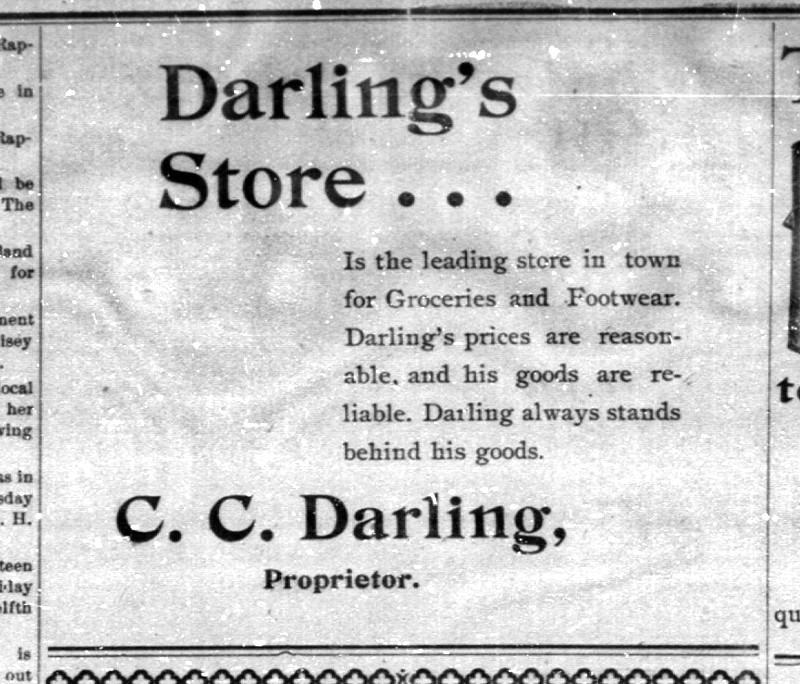
C.C. Darling's advertisement appeared in the Sentinel Leader, April 1901
Charlie married Cora Alice Basenback at Sparta in 1884. Soon after, he became part of a business, Darling & Roberts, with his brother-in-law, Edson Roberts. Before long, Darling decided to go it alone and sold his interest to his partner. By 1890, he established his grocery and footwear business in a small storefront just east of Hastings Drug Store (later Wolf's) near Division and Union. As Arzie Pinckney wrote in his I Remember column fron The Sentinel Leader about Charlie, "He proved to be a very successful and popular merchant. Like all other grocers in town, he had a good trade with the farmers.” Whatever produce they brought to sell or swap, Charlie was willing to take to sell—even if it ended up "in pig’s feed."
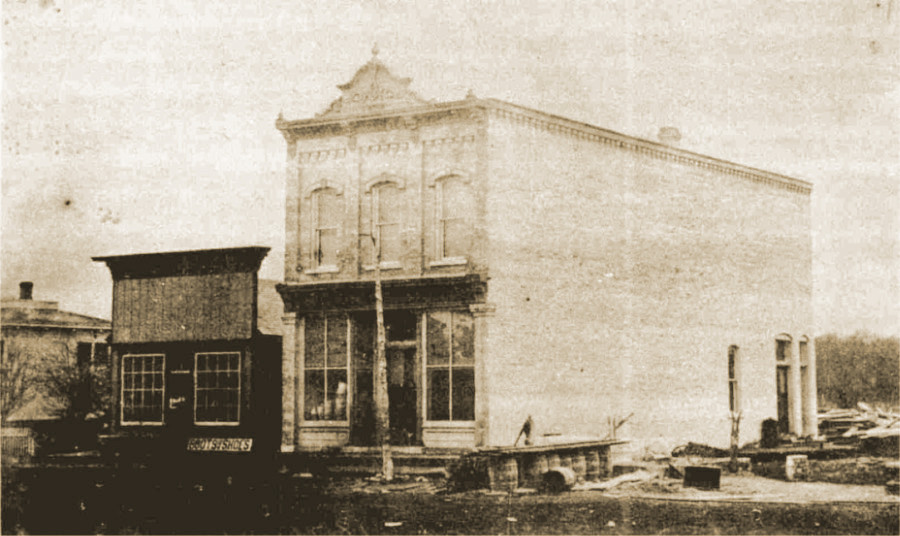
The smaller building on the left was Charlie Darling's grocery and footwear store
"Many funny things happened in those days. For one thing, the store had a poor tobacco box. It was a cigar box that set on the counter and they would empty a package of cheap tobacco in it and everyone was permitted to fill his pipe for free." As Arzie related the story, "There was the big heating stove set out from the wall so there could be a row of chairs around it and the male senior citizens could fill their pipes and sit down for an hour or so for a visit or to tell each other how the world should be and would be run if they were in the driver's seat. Of course, nothing ever happened so they could not be blamed for it, or condemned for suggesting it."
Mrs. Darling's nephew, Harry McCall, who clerked at the store liked, as Arzie said, "to liven things up for a moment. Harry would take a pinch of gun powder and sprinkle it in the tobacco and it was funny to see the faces of the men when sparks would fly out of their pipes. There was never enough powder to hurt anyone."
Risky Business
"THEY FEAR CURL LEAF.—Peach Growers Do Not Like the Present Weather." The Sparta Sentinel-Leader headline proclaimed on May 24, 1901. "The prolonged cold and wet weather, according to the Grand Rapids Press, is causing the fruit growers of this vicinity considerable anxiety lest the peach orchards shall be visited again with curl leaf, the scourge that three years ago wrought heavy ravages to the peach crop." In spite of a mild winter, the fungus was gaining a foothold as early signs of the blight were evident.
Beyond the hardships and challenges faced by farmers in just getting to the point of harvesting their fruit crops, getting them to market at their peak condition was another roll of the dice. Shipping by train opened up new markets to fruit producers for the potential of higher profits, but at what cost? A 1901 Detroit Free Press article blared the alarming news: "PEACHES DOWN TO TEN CENTS A BUSHEL AT SPARTA.—Sparta, Mich., August 27.—(Special.)—The fruit market collapsed here today, when the price of peaches went down to ten cents per bushel. The hot damp weather of the past few days is the cause. Some carloads of fruit have not brought enough to pay the freight. Peaches will not keep as long as the weather remains as it is now. Fruit growers in surrounding townships have already lost thousands of dollars and the end is not yet in sight. In some cases buyers have refused to handle the stock."
Disappointments from 1901 vanished as the peach harvest of 1902 began and news items, such as one from the Alpena Evening News which proclaimed "all records were broken" with some peaches which brought as high as $1.10 or $1.25 per bushel. "One morning's offering of peaches is declared to have reached the enormous total of 50,000 bushels," at Grand Rapids, while the "previous high water mark was 35,000 bushels."
An end of season report credited to the Secretary Van Asmus of the Board of Trade dated October 18, 1902, was published in Fruit Trade Journal and Produce Record. Accordingly, peaches marketed at Grand Rapids, Casanova, Sparta, Lowell, Rockford, Kent City, and Ada, amounted to a total Kent County peach harvest of 2,000,000 bushels and netted producers an average of 75 cents, per bushel.
I Remember by Arzie Pinckney
Published in The Sentinel Leader (Dec 21, 1966)
The year 1902 will long be remembered by me for that was the year that I cut off my fingers. Also, it was (up until then) the greatest peach crop for the growers around Sparta. Nearly every farmer had a peach orchard and the trees were loaded. And, of course, when it was time to pick them, they were all ready at once.
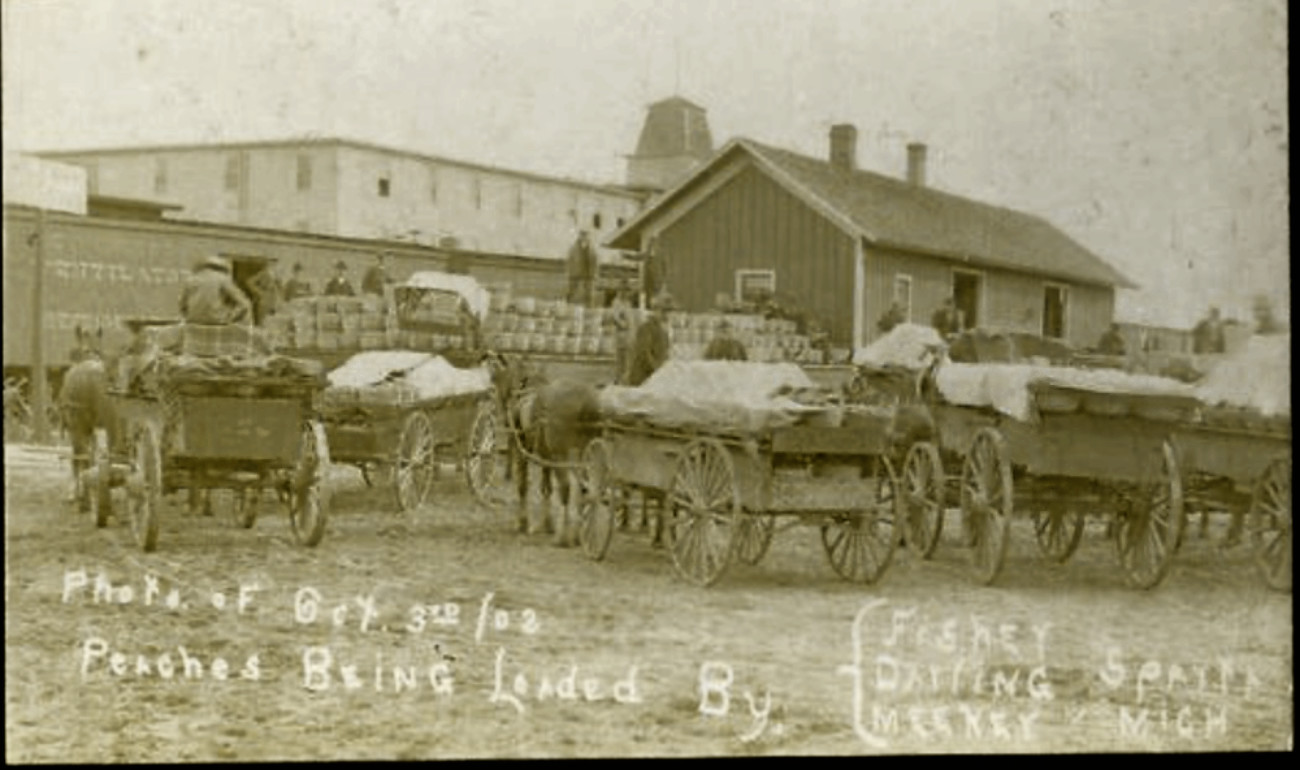
Charlie Darling, Al Meeker, and William Fisher loading bushels of peaches on October 3rd, 1902, at the Sparta freight depot. Notice the open trap door for ventilation on top of the railroad car to the left, as Arzie mentioned.
In those days, the peaches were not picked until they are fully ripe so it was necessary that they be shipped as soon as possible. For several days the railroad company would send up a string of what they called combined ventilator and refrigerator cars. But the only ventilation was just opening some trap doors in the roof and the refrigeration was some cakes of ice that were placed on the floor just before the doors were closed.
Until 1902, peaches were shipped by putting one layer of baskets on the floor, but that year, Delbert Van Wittenberg, who owned Sparta Lumber Company (now Waldeck Lumber Co.) devised a way whereby they could stack them up, I believe, four baskets high…
When the cars were loaded, the doors were closed and they began to fill another one. An evening freight would take them away to market.
Whether it was in Grand Rapids or in Chicago, I am not sure.
One day during the season, there would be as many as 100 wagons standing, waiting to be unloaded. There were also many car loads shipped out on the Grand Trunk Railroad which at that time was the T.S. & M. R.R. (Toledo, Saginaw, and Muskegon Railroad). For want of a better nick-name, it was sometimes called the 'Tough, Slow, and Miserable Road'…
That year the buyers were Albert Meeker, Charlie Darling, and a Mr. Fisher…
William M. Fisher
Who was the "Mr. Fisher", Arzie spoke of and whose name was scrawled by the photographer on images commemorating the bumper crop of peaches?
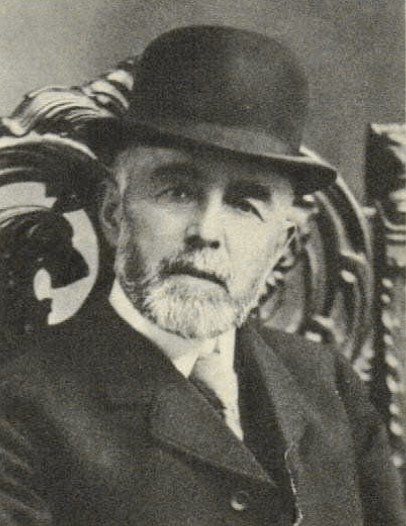
William M. Fisher portrait taken at Grand Rapids, Michigan
He was a bearded man of average height and build who had a penchant for his derby hat--but Bill Fisher was anything but "average". A grandson, author James Thurber, described him as a man who had a "compelling urge to stand out among men. He had had all his teeth capped with gold when he was still a young man, and their gleam was not only set off by a black beard but vividly accentuated by a red rose, whose stem he clamped between his teeth like a cigar."
Mr. Fisher had a fascination with photography and was known to drop by a studio while away from home on business trips just to have his portrait made.
Of humble beginnings from his birth in 1840 at Marion, Ohio, Bill grew up a farm boy, the son of pioneers. Eventually, he inherited the family farm which he cultivated until he was twenty-seven. Driven to become a businessman, he traded the country life for new horizons in the city and became a grocer who also shipped produce. Soon, he founded a produce wholesale business which grew into a massive produce commission house enterprise, William M. Fisher & Sons Co., at Columbus, Ohio.
By the turn-of-the-century, he imported produce from every state, Central America, and even Europe. Along with the bounty, sometimes an unwelcome guest smuggled themself into his warehouse. Shipments of bananas were the occasional vehicles for tarantulas, scorpions, and even the sporadic baby boa constrictor.
"In the late eighteen-nineties, William M. Fisher made perhaps his only major business blunder, and it was a magnificent one," the grandson wrote. William was intrigued by the allure of mining gold in the Blue Ridge mountains of northern Georgia. Along with a group of friends, they purchased the sizable Dahlonega Gold Mining Company in 1898. The company which was capitalized with $5,000,000, built and outfitted a massive facility with a modern stamp mill to crush the rock "capable of milling 500 to 700 tons of ore per day" declared The Savannah Morning News (1/21/1900). Houses were constructed as was a grand hotel in anticipation of the start of mining operations that were expected to employ as many as 500 men. Efforts were underway to extend the railway from Gainesville to Dahlonega. Operations commenced on March 10, 1900, as an elaborate event hosted “700 stockholders, who are New York, Ohio, Michigan, and Kentucky capitalists” along with other dignitaries.
Fisher was the purchaser of Meeker & Darling's peaches.
Michigan State Farm Statistics reported in 1902 that Sparta had 474 acres of peaches which produced an impressive 66,544 bushels, up significantly from the 1901 tally of 391 acres which yielded 28,706 bushels--and 19,316 bushels of peaches in 1900.
The 1902 season was so successful, that an enquiry was published in the Fruit Trade Journal and Produce Record under the headline: Wants Michigan Peaches. Columbus O., Aug.17, 1903. William M. Fisher, of William M. Fisher & Sons Co., is one of the heaviest operators in Michigan peaches, and last September he shipped from Grand Rapids over 90,000 bushels of the fruit. It was mostly bought at Sparta, and he will buy at Sparta again this year, and at several other points hereabouts. He will take all he can get.
At 84 years old, John Symes passed away on 23 Aug 1901 and his son James continued the operation of Cherry Hill Farm. On occasion, with his own brand of wit and wisdom he wrote engaging articles for the National Fruit Growers publication, one of which was included in their July 1903 issue.
The Cherry.
Cherry Hill Farm, Sparta, Kent County
by J. A. Symes
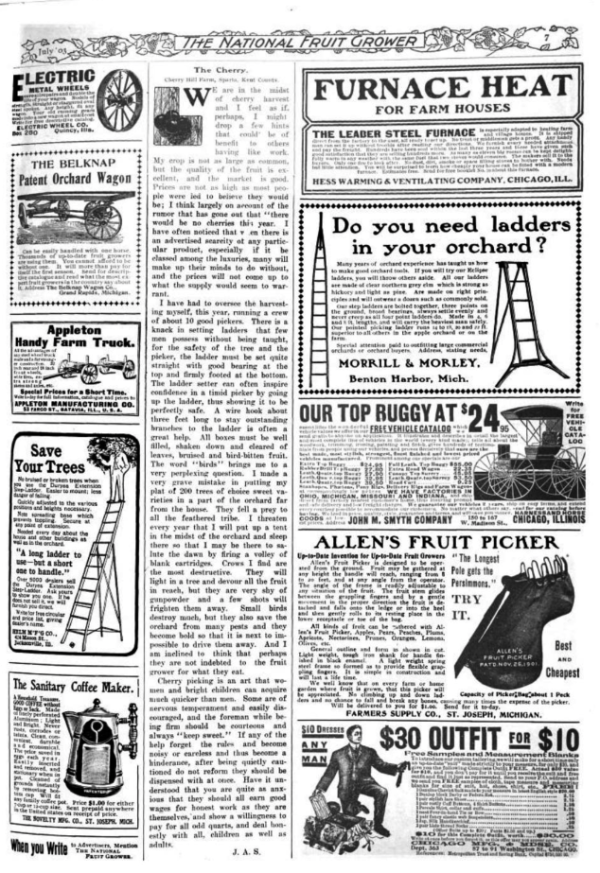
J. A. Symes' July 1903 article, "The Cherry", appeared in the National Fruit Grower publication
We are in the midst of cherry harvest and I feel as if, perhaps, I might drop a few hints that could be of benefit to others having like work. My crop is not as large as common, but the quality of the fruit is excellent, and the market is good. Prices are not as high as most people were led to believe they would be; I think largely on account of the rumor that has gone out that "there would be no cherries this year." I have often noticed that when there is an advertised scarcity of any particular product, especially if it be classed among the luxuries, many will make up their minds to do without, and the prices will not come up to what the supply would seem to warrant.
I have had to oversee the harvesting myself, this year, running a crew of about 10 good pickers. There is a knack in setting ladders that few men possess without being taught, for the safety of the tree and the picker, the ladder must be set quite straight with good bearing at the top and firmly footed at the bottom. The ladder setter can often inspire confidence in a timid picker by going up the ladder, thus showing it to be perfectly safe. A wire hook about three feet long to stay outstanding branches to the ladder if often a great help. All boxes must be well filled, shaken down and cleared of leaves, bruised and bird-bitten fruit. The word "birds" brings me to a very perplexing question. I made a very grave mistake in putting my plat of 200 trees of choice sweet varieties in a part of the orchard far from the house. They fell prey to all the feathered tribe. I threaten every year that I will put up a tent in the midst of the orchard and sleep there so that I may be there to salute the dawn by firing a volley of blank cartridges. Crows I find are the most destructive. They will light in a tree and devour all the fruit in reach, but they are very shy of gunpowder and a few shots will frighten them away. Small birds destroy much, but they also save the orchard from many pests so they become bold and it is next to impossible to drive them away. And I am inclined to think that perhaps they are not indebted to the fruit grower for what they eat.
Cherry picking is an art that women and bright children can acquire much quicker than men. Some are of nervous temperament and easily discouraged, and the foreman while being firm should be courteous and always "keep sweet." If any of the help forget the rules and become noisy or careless and thus become a hinderance, after being quietly cautioned do not reform they should be dispensed with at once. Have it understood that you are quite as anxious that they should all earn good wages for honest work as they are themselves, and show a willingness to pay for all odd quarts, and deal honestly with all, children as well as adults.
Harvests Record Crop of Cherries On 82nd Birthday
Sparta Pioneer Remembers When Michigan Was Wilderness.
Special to The Detroit Free Press 30 Jul 1922, Detroit, Michigan
Grand Rapids, Mich., July 29--Just to celebrate his eighty-second birthday, J. A. Symes, of Sparta, harvested a bumper crop of cherries on his farm on which he has lived for 77 years.
It was only 18 months ago that Symes relinquished any part his farm duties. This year he has looked only after the eight acres of cherry trees on the 83-acre farm which was his homestead.
The octogenarian was born in Shelby county, Ohio, in 1840. His parents came to Grand Rapids in 1845, but remained only long enough to prospect for land and take up a claim. When the family moved to Sparta its only guide was the blazed trail of the surveyors along the section lines.
The location was reached at 9 o'clock one summer night and the camp pitched was then the beginning of the farm life of the Symes pioneers. Eighteen years later, when the forest had given way to agriculture, J. A. Symes married Miss Eleanor Ballard, who still lives and is as active and vigorous as her husband. Her family is the one from which Ballards Corners, which came into existence before Grand Rapids was established, takes its name.
Symes father was a mason by trade and helped build the abutments for the first bridge across Grand river. Later he laid the engine bed for the first furniture factory operated by steam power.
The Sparta pioneer was born a Republican, his first vote being for Lincoln, but he became a prohibitionist and remained so until the eighteenth amendment became effective. Now he is a Republican again.
Peach Ridge Fruit
Growers Association
PEACH RIDGE FRUIT AREA HAS BUMPER CROPS
Better Fruit is Developed
Million Bushels of Apples and Peaches Is 1941 Estimate
by H.J. Kurtz in Sunday, Sept. 14 Issue of Grand Rapids Herald
Add 250,000 bushels of peaches and 750,000 bushels of apples and you have a million bushels of fruit in anybody's arithmetic.
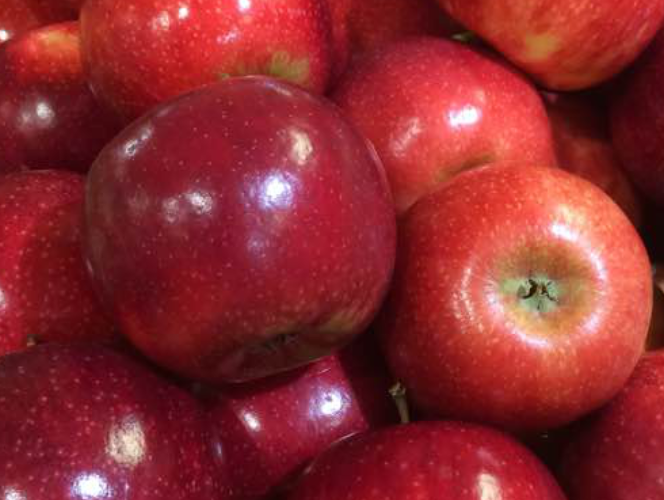
Sparta apples
That's the 1941 "take" of the expert fruit growers who operate the large and profitable orchards in the Peach Ridge area southwest of Sparta. These ace horticulturalists are enjoying their most successful peach harvest since they organized the Sparta Peach Ridge Fruit Growers Association in 1929.
Which makes it appear fruit growing is another one of the industries that are back on a pre-depression basis.
Sold on Grounds
By the time the season ends in another week, Otto Klenk, president of the association estimates at least 250,000 bushels of choice peaches will have been sold in the Peach Ridge fruit belt--an area only seven miles long and two miles wide. Ninety percent of the Peach Ridge crop is sold in its own orchards and warehouses, and truckers and buyers representing most of the midwest markets have already trucked away thousands of bushels of such early varieties as South Havens and Rochesters.
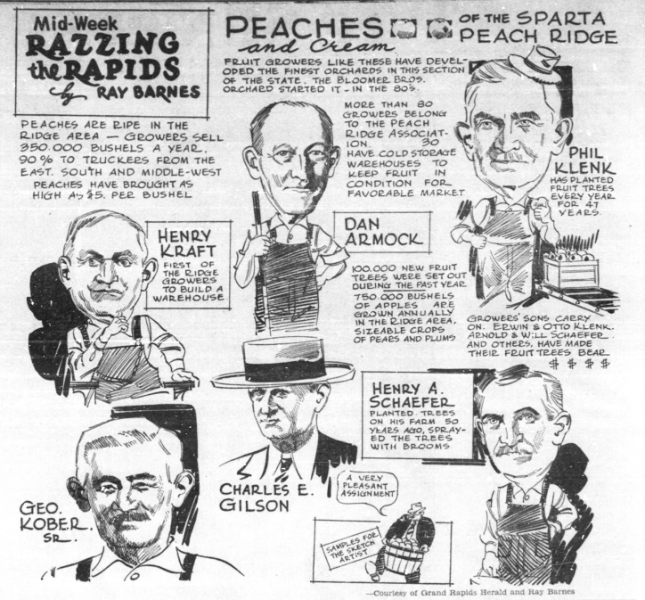
Sparta's Peach Ridge peach growers--The Grand Rapids Herald, also published in The Sentinel-Leader, courtesy of STHC Newspaper Archives
Now, as the season draws to a close, the luscious, colorful Hales and Elbertas are moving in truckload lots to distant markets.
In the Peach Ridge fruit belt, comprising orchards in Sparta, Alpine, Walker, Tyrone and Plainfield townships in Kent County and Wright and Chester townships in Ottawa County, are some of the most successful peach and apple orchards in the state. Klenk estimates that at least 750,000 bushels of apples will be harvested there this fall, as well as a fine crop of pears, plums and grapes raised by expert fruit growers of many years' experience.
Began Years Ago
Some of these orchardists are the sons of Kent county pioneers who began growing fruit in that section more than 50 years ago. Handed down from father to son as a family heritage, the well kept farms are operated with pride and profit by their owners, who live in large, comfortable homes and have added modern storage plants, electric refrigeration and ventilating fans to their fruit growing equipment.
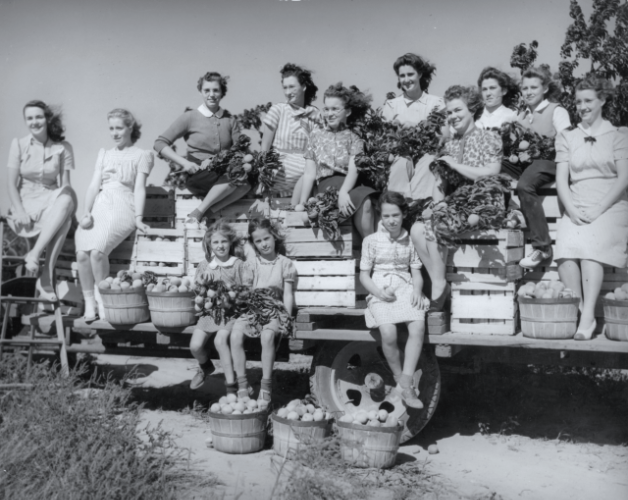
Daughters of fruit growers in the Peach Ridge District southwest of Sparta with bushels of fresh picked peaches posed for a photo at the orchard of Phil Klenk and Sons. Standing: Natholee Schneider, Margaret and Thelma Dunneback, Dorothy Armock, Frances Dunneback, Agatha Armock, Elizabeth Dunneback, Lucille Finkler, Rosemary Umlor, and Catherine Dunneback. Seated: Norma Fleet, Lois and Phyllis Klenk--The Sentinel-Leader, dated 18 Sep 1941, from the Sparta Township Historical Commission archives
Among the veteran fruit growers is Phil Klenk, who began orcharding in the Peach Ridge district 47 years ago and built one of the first modern refrigerated plants in that vicinity. In the orchards he farms with his sons, Erwin and Otto, there are now three of these plants, their warehouses have a total capacity of 36,000 bushels of fruit. Annual crop of the Klenk orchards is 6,000 bushels of peaches and 25,000 bushels of apples.
The Peach Ridge Fruit Growers' association now has 80 members. Other officers besides President Otto Klenk are Lowell McKinney, secretary; Harold Wilson, treasurer; Harold Chase and Leo Dunneback, directors.
Latest Methods
Also enjoying a bountiful 1941 harvest is the West Sparta fruit section, four miles west of Sparta, where expert fruit grain and dairy farmers three years ago organized an association which now has forty members. Officers of this association are Julius Nussdorfer, president; Carl Schwartz, vice president; Roland Kraft, secretary; Franklin Reister, treasurer; and John Ritz and Curtis Swarthout, directors.
Success of the fruit growers in the latter area also commands the respect of the horticultural world and has attracted truckers and buyers from a wide area.
Horticulturalists of both the Peach Ridge and West Sparta fruit belts improve their crops by using the latest methods of fertilizing, spraying and pruning. Every year they plant at least 100,000 new fruit trees of many varieties to replace wornout or broken trees, or to set new orchards.--The Sentinel-Leader, published on September 18, 1941; from the Sparta Township Historical Commission newspaper database
Prisoners of War
Help Area Farmers
December 9, 1941, two days after the shocking attack on Pearl Harbor, the USA entered World War II. As young men joined up to fight the war, women stepped forward to fill a variety of jobs--in and out of the nation's factories. By spring, Americans were encouraged to grow "victory gardens" as ration stamps were issued for necessities such as food, gas, and clothing. People helped each other learn necessary skills in canning and gardening clubs. Blackout tests along with sacrifice through military service, volunteerism, rationing, and materials collection efforts soon became a way of life.
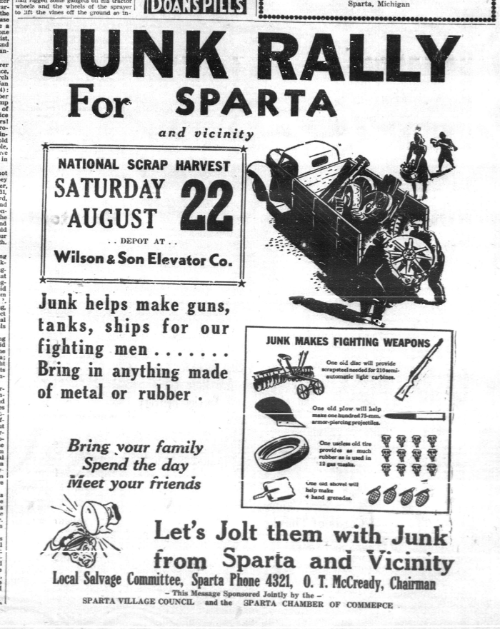
A notice for a junk rally from The Sentinel-Leader dated 20 Aug 1942 seeking donations of scrap iron, other metals, and rubber--from the STHC newspapers archive
By June, the headline read: BOYS CAN SECURE SUMMER EMPLOYMENT ON NEARBY FARMS. The need was already pressing. Fred Humeston announced in a Sentinel-Leader article the matching of workers to farms would be handled locally, not through an office in Grand Rapids which under the "Enlist in America's Land Army--Speed the Food for Victory Program" had already failed to secure jobs for any of the twenty-two Sparta boys who signed up. The local employment service would be managed by Dody Ryan at the Sparta fire barn to accept applications from boys aged fourteen and up interested in part-time or full summer work on area farms while farmers were asked to submit their enquiries. Even with these efforts, worker shortages steadily grew. It was especially apparent during crop harvest time.
As schools prepared to open, O.E. Balyeat, voiced his opposition to the closure of schools and the enlistment of teachers. In a local news article dated 20 Aug 1942, Balyeat strongly encouraged school attendance in spite of the shortage of labor, but conceded, "A little later during the apple picking and other rush times on the farm, the school will be liberal in excusing those who will work on the farms for a reasonable length of time with the opportunity of making up the school work." And he was true to his word.
October saw Sparta area farmers place help wanted ads in the local paper for apple pickers and women to sort and pack apples. Even the youngsters contributed to the task. Kent City High School announced afternoon class cancellations so students could work on farms in the effort to harvest the apple crop because the need was so great.
An attention getting headline, "Sparta Defeats Lee High of Grand Rapids, 27 to 0", and the opening paragraph spoke to the remarkable strength and stamina of these young men: "Seemingly unhampered by a lack of practice during the past week due to the fact that many of the players were picking apples, a strong Sparta team scored in each period to slaughter Grand Rapids Lee to the tune of 27 to 0." Sparta's team members included: Sheldon Durham, Robert VanAntwerp, Gordon Goodfellow, Carl Curtis, Vernon Cumings, Frank Hall, Carl Inman, quarterback Alton Berry, halfback Cart Badgerow, James Eynon, and Dick Stebbins. Many of these young men would soon trade jerseys, helmets, and footballs for military uniforms, boots, and rifles.
The Peach Ridge Fruit Growers' Association numbered over one hundred farmers in northwest Kent and Ottawa counties. They successfully petitioned the federal government to oppose ceiling prices on peaches and other perishable fruit as it would only add to their hardships. Their August 1943 resolution cited the peach crop was only 40% of what it had averaged over the past decade and an "acute shortage of labor and increased cost of picking the crop" as reasons to oppose the proposal. Many growers lost their entire cherry crop and suffered losses of fruit trees to winter kill. The price ceiling, if enacted, would fall "below cost-of-production".
German prisoners of war captured in North Africa from Rommel's elite Afrika Korps were shipped onboard empty troop transfer ships on the return trip to the U.S. and housed at military bases around the country. In Michigan, the Germans, as well as interred Japanese-Americans from a camp in Arkansas, were first used as farm labor and in a cannery plant at Benton Harbor during the 1943 crop harvests. The trial project was deemed a success. Based out of Kalamazoo's Fort Custer, temporary camps were built around the state for screened volunteer German prisoners who were willing and able to work in a variety of agricultural and industrial positions.
- To Do Farm Work?
Chicago--(AP)-- A plan to use groups of war prisoners this summer on farms in Michigan, Wisconsin and Illinois was announced Monday by Maj. Gen. Henry S. Aurand, commanding officer of the Sixth Service Command.
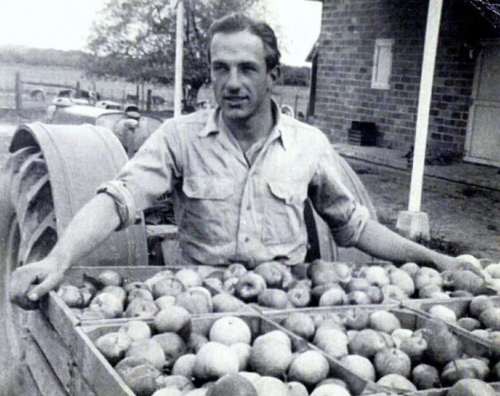
Roland Detshel worked at the Merlin Kraft farm
Prisoners will be assigned under soldier guard to farmers who can use a half dozen or more men. The prevailing wage in the community will be paid but the prisoners will receive only 80 cents a day in the form of accruing credit or script they can spend at camp exchanges. The rest of their daily earnings will go to the treasurer of the United States.--Ironwood Daily Globe published 8 Mar 1944
A crowd of 200 fruit growers from Kent, Ottawa, and Muskegon counties "met for the purpose of discussing proposed plans of erecting a war prisoners' camp east of Sparta and to determine how many prisoners would be required to harvest the fruit crop of the three counties," according to an August 3rd, 1944 report in The Sentinel-Leader. County farm agents tallied the survey for the expected amount of labor needed and announced it was over 300 men.
Next, Peach Ridge Fruit Growers Association President, Otto Klenk, led a discussion and appointed a special labor committee to contact army officials which consisted of: Jack Fraleigh, Walter Umlor, William A Schaefer, Ed Mawby, and Richard Thome. They would request prisoner workers from the 21st of August for the peach harvest though October to bring in the apples.
The same newspaper included an article by Waldo F Fuller, Major F.A. Area Commander entitled, "Let the Captives Alone" in which he cautioned civilians to stay away from the temporary prisoner camp and avoid mingling, especially women. A reduction in productivity would result in the removal of the camp and "would mean less food for civilians--the civilians who disrupted the program and all the rest of us." He went on to say, "We had best remember these men are our enemies."
Three weeks later, The Herald-Paladium out of Benton Harbor reported, "...a work camp is contemplated for rural Sparta. Fruit growers and farmers of that vicinity have applied for WMC certification, asserting that they need 400 men."
The affirmative decision came swiftly. On Monday, FBI official, Howard Bobbitt, was the guest speaker at the Sparta Rotary Club luncheon meeting as he emphasized "War prisoners, such as will be encamped in Sparta during the next few weeks to assist orchardists in the harvesting of perishable fruit, are not to be considered as criminals," as he prepared community leaders for what to expect. "When assigned to special tasks of labor there is always one guard for ten prisoners. It is the duty of these guards to prevent civilians from coming in close contact with the enemy captives."
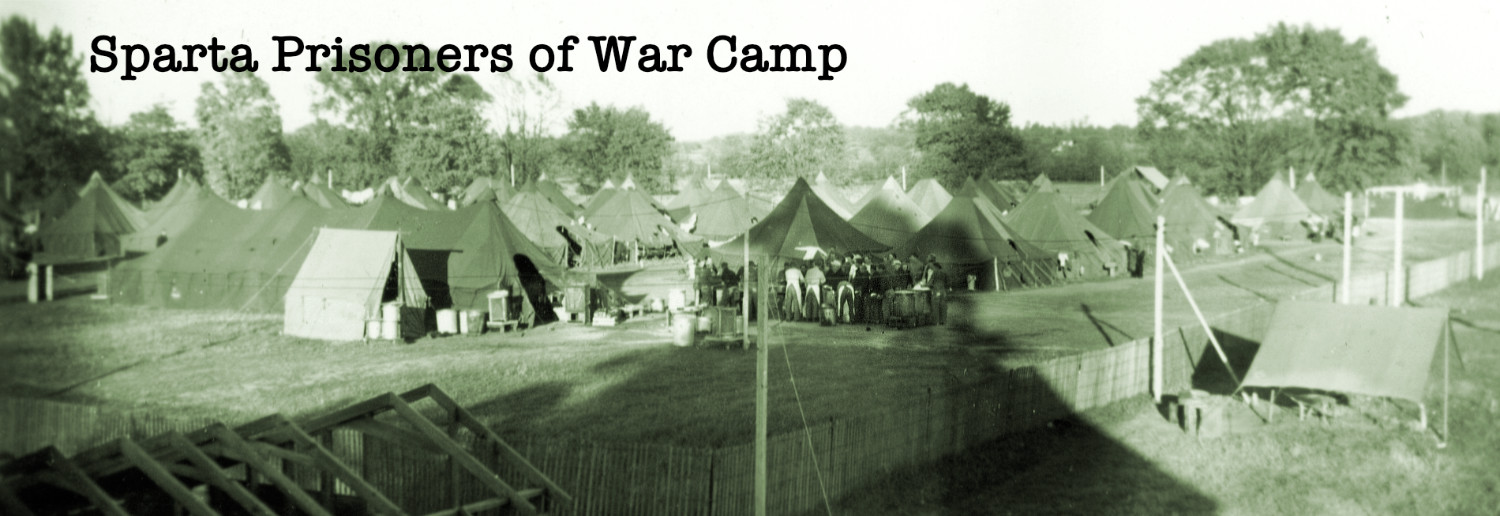
Sparta's prisoners of war camp held about 400 Germans in the fall of 1944 as a valuable source of labor for area farmers
On the 31st of August the public was informed "Sparta to Get War Prison Camp Friday" as 400 men would be relocated from Barryton in Mecosta county to the outskirts of the village in the vicinity of East Gardner and Martindale. The Kent, Ottawa, and Muskegon counties fruit growers and farmers' request was certified by the manpower board "that insufficient labor is available to harvest the bumper crop of peaches and apples." It was reported "a field camp... will be set up in four hours Wednesday... Major O.W. Franklin from the army engineers office, will supervise the erection of the camp." The prisoners would arrive on Friday. Mr Claude VanCoevering emphasized, "enemy captive labor is not being brought to the district to replace labor but rather to supplement labor and to assist in a 100% harvesting of the crop."
The idea of German prisoners of war at work in orchards to harvest the fruit was not universally welcomed by the locals, partly due to distrust, fear, the painful reminder of loved ones overseas or those sacrificed to the war. Some felt the German war prisoners were being "coddled". After all, prisoners who chose to work had access to what many considered luxury items most Americans could not obtain them for themselves. Perhaps they did not think of the possibility it served as an incentive to encourage prisoners to step up and fill the work force vacancies left by our soldiers or that most of the prisoners were just good people motivated by a desire to get out of the camp and be productive.
Otto Klenk
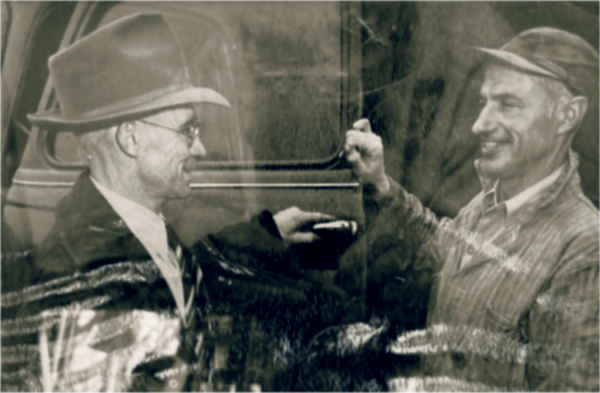
Brothers Otto and Erwin Klenk, left to right--photo courtesy of Ron and Barb Klenk
November 20, 1895, marked the birth of Otto Fred to Philip George and Barbara (Miller) Klenk of Sparta. Otto and his siblings: Esther, Erwin, Althea, and Winnifred grew up on the 240 acre family farm purchased in 1894 by his grandfather, John Frederick Klenk, at Ten Mile Road and Fruit Ridge. The north part of the Klenk farm shared a property line in Section 32 with the Bloomer Brothers' farm, who were the first to plant peaches on "the Ridge".
By 1941, three storage facilities were built on the farm as the Klenks cultivated apples and peaches on 125 and 25 acres, respectively, along with cherries and blackberries. During the summer of 1939 they harvested 20 tons of sour cherries, which is even more impressive knowing they were hand-picked.
Otto married a school teacher, Alice Marie Davenport, on 7 Dec 1929, at Trinity Lutheran Church, west of Sparta. The daughter of Fred and Christine (Vogel) Davenport, Alice had taught students in one-room schoolhouses at Armada (located in Macomb county north of Detroit) and Ionia before her marriage. They were blessed with three children: Phyllis, Lois, and Ronald.
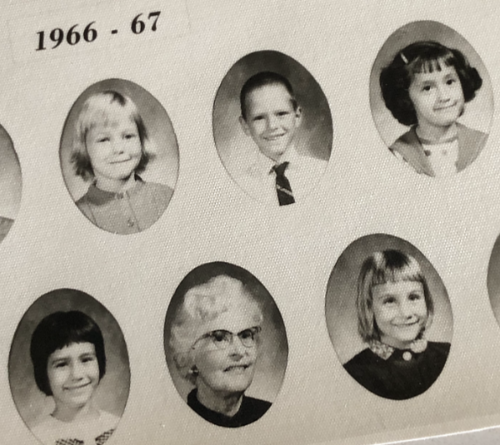
Mrs Klenk with some of her 32 first grade students at Sparta Central Elementary in 1966, pupils left to right: Cheryl Anderson, David DeRuiter, Patty Norton, Vonnie Magoon, and Debbie Beuschel
Widowed after raising her own family, Alice returned to the classroom in 1957 at Sparta Central Elementary. Later in life, Alice achieved a personal goal when she graduated from college at 65 years of age with her teaching degree shortly before her 1969 retirement. Mrs Klenk was a wonderful first grade teacher who dedicated 23 years to education.
For many years, Otto served in the capacity of President of the Peach Ridge Fruit Growers Association. He, along with his father and brother, Erwin, spoke at symposiums held around the state on the topic of packing house management, air-cooling, and cold storage for the Michigan State Horticultural Society.
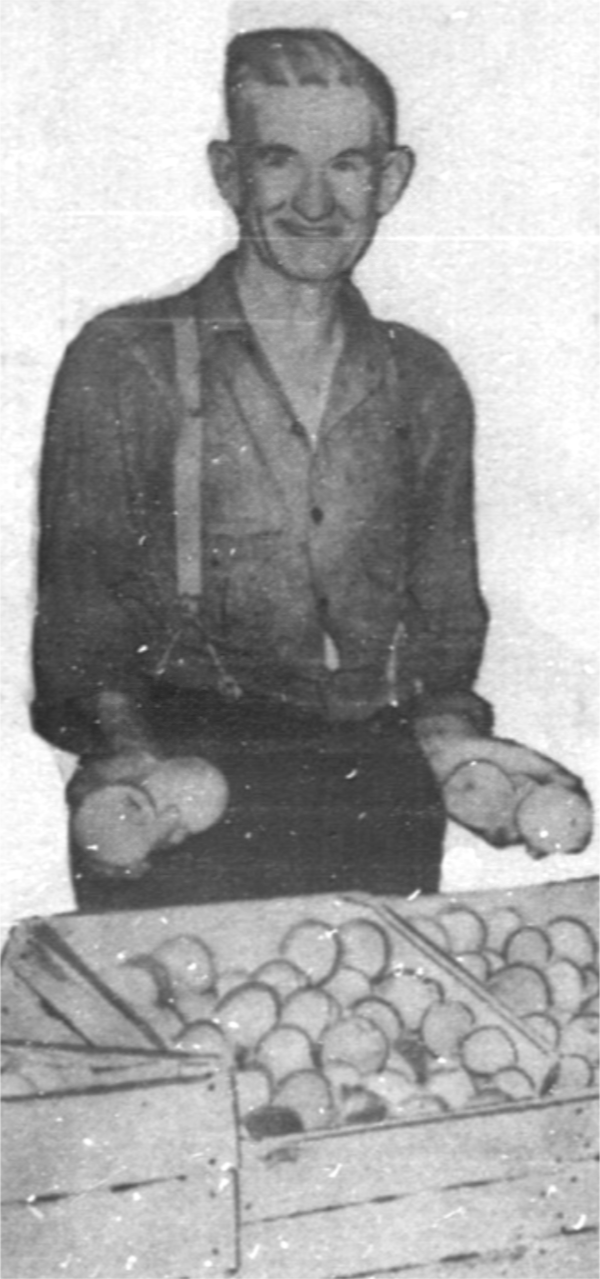
Phil Klenk with peaches harvested from the family farm
"My father put up the money for the camp," recalls Ron Klenk, "It was $600. Later, he did get it back."
"Mother was apprehensive," which was understandable when one considers the stern warnings officials published in the newspaper. Alice tamped down her worries and extended kindness and hospitality to the workers. "She made coffee for the men as they ate their boxed lunches."
A youngster at the time, Ron Klenk remembers the men brought him candy bars. "Everyone spoke German in our area. Grandfather spoke German and our church held a German service once a month." Communication was key to the success of the program. Because of the predominance of German speakers among the residents, a level of trust, respect, and even some friendships developed.
In addition to the apples, the men picked corn by hand for the Klenks. "They had one guard. One day he went to the bar and got drunk. He hit a tree in the yard coming back to the farm. There was blood all over inside the truck. He fell onto the ground and the gun was on the front seat."
- War Prisoners Harvest Fruit
Demands for prisoner of war labor, far exceeding the available manpower, proves the far-sightedness of Otto Klenk and his labor committee of the Peach Ridge Fruit Growers Association. "No help available" is the answer received by many growers needing harvest hands to pick the fast-ripening apple crop.
This source of labor was contracted to supplement the local labor supply and not to replace the regular pickers usually available to harvest this crop. This fact is apparent by the number of growers still short-handed in spite of appeals for free labor through County Agent offices in Kent, Muskegon, and Ottawa counties.
Commencing with the peach harvest and early apples, the prisoners of war have been used in several agricultural ventures before starting the winter apple harvest. Satisfactory results have been secured in silo filling, corn shocking, celery harvesting, potato digging and food storage work.--The Sentinel-Leader from the 5 Oct 1944 edition
Walter Ebers
Frank and Anna Margaretha (Schindler) Ebers welcomed the birth of a son on December 29, 1897, they named Walter Henry. He was raised to adulthood on the 116 acre Ballards Corners farm his father purchased from Ed Cummings in 1891. By 1920, their land holdings included nearly a quarter of Section 34 plus the original parcel across Ten Mile Road in Alpine township.
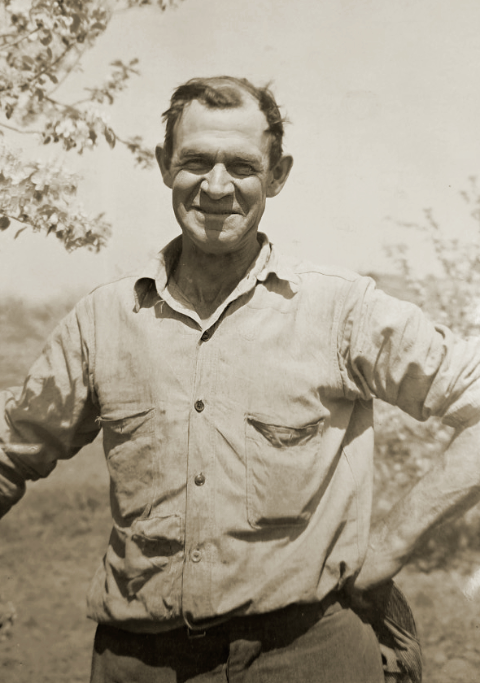
Walter Ebers in his apple orchard--photo courtesy of Kathleen Ebers
As a young man, Walt married Kathryn A Heuss, in 1926, and the couple settled into life on the family farm. Within a dozen years, they welcomed a son and two daughters: Rock, Margaret, and Kathleen.
Walt Ebers was one of those who faced a lack of workers necessary to ensure the bountiful crops were harvested in a timely manner. As stated in the news article, the 400 prisoners at Sparta weren't enough to meet the need for labor during peak demand. Consequently, some farmers had no choice but to drive to other camps in order to get their workers.
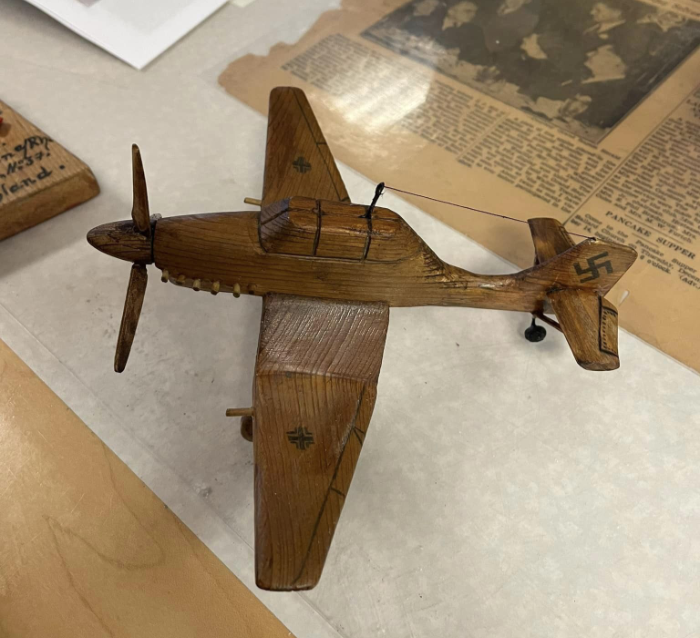
Junker 87 Stuka Dive Bomber carved for Rock Ebers by a German prisoner who worked on the family farm during the 1944 harvest
"My dad had 25 POWs on our farm." Kathleen Ebers explains, "My memories (I was 5) are of my father going to Camp Grant every morning in a big flat bed truck to pick them up. They would come with a guard with a gun! They worked in the orchard and came up to the storage at noon. My mom would see that they had a meal. (They were fed breakfast at the camp.) Then back to work. My dad would take them back to Camp Grant in the late afternoon." Even with gasoline rationing, Walt made the 40-mile round trip twice a day because he had no other options.
"One POW must have taken a shine to my teen-aged brother, Rock, because he carved an airplane. It was a copy of a Junker 87 Stuka Dive Bomber--a real treasure that I have." The artist signed his work on a spare piece of wood: "Souvenir from Hermann Alles" along with his address. Kathy recently had the airplane restored.
"My mother, through her friend, Mrs Waldherr--a neighbor of ours who spoke, read, and wrote German--was able to write to each prisoner's family to let them know that their son was safe and working on our farm."
Mina Waldherr
"My grandpa, met a man in Hungary who was going to America," explains Catherine Waldherr D'Amour. "Grandpa didn't have much money so the man offered to pay his way if he would work on his farm in Minnesota before going to Montana." Martin Waldherr immigrated from Bremen, Germany, on the 18th of July 1908 on board the SS Bullow with a final destination of Dawson County, Montana, via Ellis Island at New York. He was born at Szentjanos, Moson, Hungary, in 1883. When the 1910 Federal Census was recorded, Martin was listed as a "hired man" on the farm of John and Mary Fuchs at Lake Henry, Stearns, Minnesota. By the end of the next year, he arrived at Montana.
On August 25, 1915, his naturalization was granted at Glendive, in Dawson county, Montana. Martin received a land patent dated 1916 for 320 acres to homestead in the wilderness at Horse Creek in McCone county, Montana, where he raised grain.
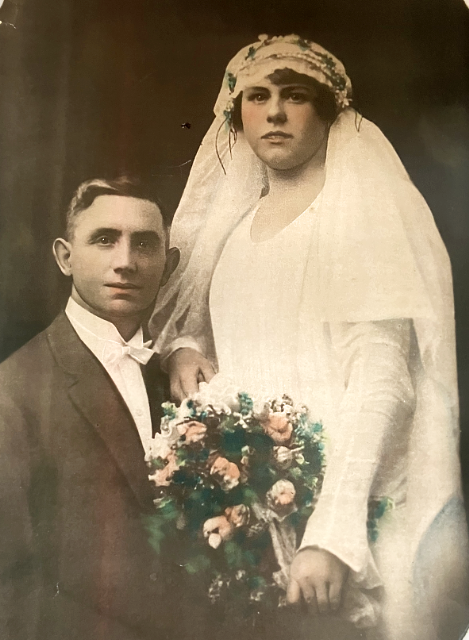
Martin and Mina's wedding portrait--courtesy of Catherine Waldherr D'Amour
"A friend knew grandma," Catherine related the story told to her by her Aunt Mary. Hermine Schmejda or "Mina", as she was called, was born on December 3, 1898, at Meidling, Wien, Vienna, Austria. "She came from a prominent family but her parents died when she was young. She lived with another family doing housework." Martin made the journey to Europe, the couple were introduced, and married on the 9th of February 1925 at Burgenland, Austria. Fortunately, German was the native tongue of both.
The newlyweds soon departed the port at Cherbourg, France, onboard the White Star line's SS Olympic and arrived on 24 Mar 1925 at New York City. Catherine points out, "The Olympic was the sister ship of the Titanic." While conducting family genealogy research, it was difficult for Cathy to locate her grandma on the ship manifest because they had mistakenly recorded her as an "Australian".
The enumeration of the 1930 Federal Census revealed many of the twenty-one families who settled on homesteading land near the Waldherrs were immigrants from Ireland, Czechoslovakia, Russia, Germany, Norway, and Sweden. Most raised grain and a few had sheep or livestock ranches. Sometimes dry summers withered the crops and winters were harsh. Life was not easy on the Montana frontier.
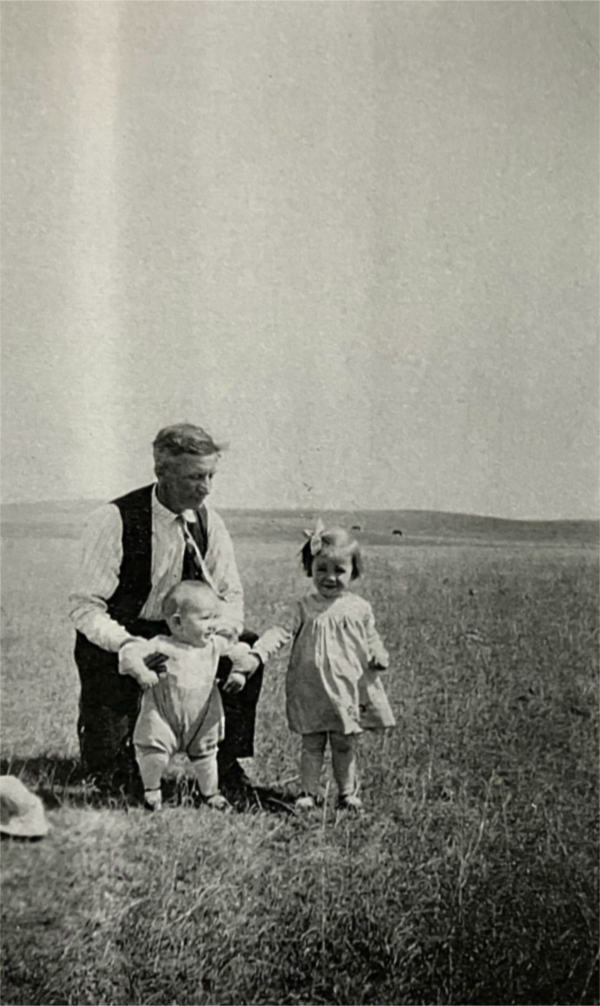
Martin Waldherr with Carl and Mary in Montana--photo courtesy of Catherine Waldherr D'Amour
The man who owned the adjoining property was George Virgil Felt born at Wiota, Cass county, Iowa in 1885 and who was a World War I veteran. Call it a coincidence or fate, George's older brother was none other than Garnett Smith Felt, born on the 4th of July in 1879--a doctor and surgeon at Michigan Soldiers Home in Grand Rapids with an established farm at Sparta.
Martin and Mina decided they had had enough of the weather in Montana. The family made the trip east by train in 1937 as they relocated to the eighty acre farm of Dr G.S. and Bessie Louise (Stockwell) Felt. They were practically within a stone's throw of the Ebers' home. Martin was employed as a farmhand for the doctor. The following year, a daughter, Ann, completed the Waldherr family. She and her older siblings: Mary, Carl, Max, Martha, and Elsie graduated from Sparta High School--with the exception of Carl. "At thirteen, he lived at Scottville to work and send money back to the family," Catherine says of her father. While away from home, he stayed with their former neighbor, George Felt.
"Grandma was an amazing seamstress. She could make patterns and made clothes for many people. She would take old coats to make into new coats for me. During the war, she made clothes to send to her family in Austria." Catherine spoke with admiration, "Today, she would be a designer." In addition to writing letters to the families of the Walt Ebers' German workers, most likely she did the same for Dr. Felt.
Harley Smith grew up on the east side of Martindale. Beyond his backyard was the POW camp. His mother, Dorothy, told him never to go down near the men. And he still remembers listening to the Germans singing around their camp fires at night.
Within the last week of October, the prisoner of war camp closed. K.K. Vining, the County Farm Agent, stated "This group of prisoners have been good to work with. We don't know of any serious trouble and in some camps there has been plenty. In the Sparta section there are fruit men of German descent, many who can talk the language. Talking to these men in their own language no doubt helped a lot. One grower had a prisoner who was a farmer in Germany. Had pictures of his farm with him. Our farmer asked the prisoner who was working his farm. The prisoner told him that his wife had written saying she had a Russian and Dane prisoner of war working for her."
As harvest season arrived in 1945, farmers relied on young people. On the 23rd of August Sparta schools ran a notice the start of the school year would be delayed for a week at the request of many community farmers so students could be employed harvesting crops.
- K.K. Vining Tells About Dr. and Mrs. G.S. Felt
Editor's Note: Following is an excerpt from "Farming in West Michigan," a Sunday column by Keats K. Vining in the Grand Rapids Press. This particular column appeared in the June 18 issue.
Driving up to Peach Ridge on 10-Mile Rd., one day last week I was sorry to learn that Dr and Mrs G.S. Felt had left that morning to make their home in California near their son, George. I was sorry not to have seen them before they went.
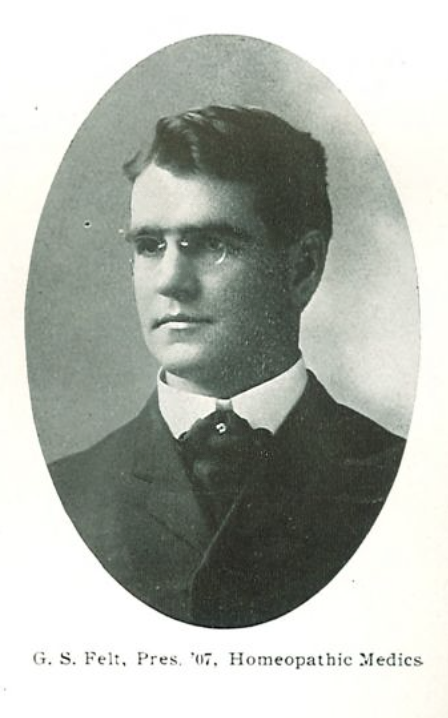
Dr G.S. Felt, University of Iowa, 1907
Dr Felt, with Carl Kober and the late James Anderson, were sponsors of a 4-H livestock club that operated for 30 years. George Felt, one of the charter members of that club, is today one of TWA's top pilots.
When fruit became a leading crop in the Peach Ridge area, Dr Felt planted apples. They grew well. He also built a storage. For the last few years both orchard and storage had been rented.
During World War II Dr Felt was one of several Peach Ridge fruit growers who had a group of German war prisoners pick his apples. When they left, he had all their home addresses. Some correspondence ensued.
Then Dr Felt planned a trip to Europe. He wrote these men he was coming and would like to see them while in Germany. He planned about a three-day visit. It extended into 10 days. He made a second visit to visit them.
George Felt, as a top TWA pilot, could get plane passage for his mother and father. Dr Felt made several trips to Europe and the Near East. He could always tell some interesting stories about people he met and also took many good colored slides.
His new California home will be at Davis.
Peach Ridge folks had an open house for the Felts at the Clarence Allen home. Nearly a hundred folks came to pay their respects and say goodbye to good neighbors.
The farm was purchased by the Klein Brothers of Peach Ridge.--The Sentinel-Leader 28 Jun 1961
The Apple
Smorgasbord
by Cindy Laug
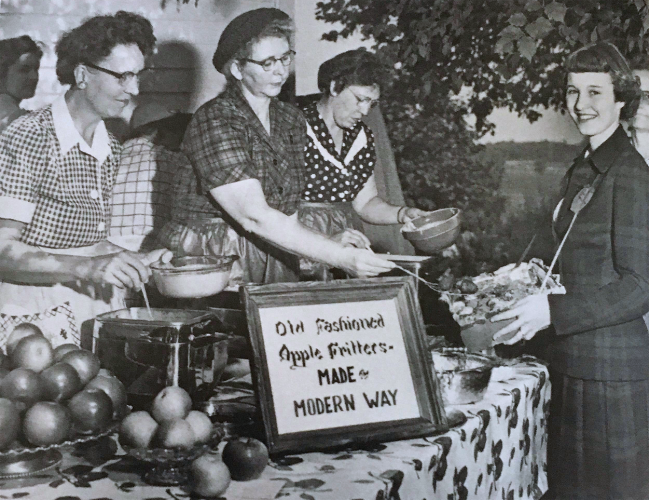
Janet Klein, Gladys Davenport, and Alma Gillett with Apple Queen Carol Fahling at the 1953 Apple Smorgasbord
Over the 20 year span of the Apple Smorgasbords, attending dignitaries included Michigan governors (Williams and Romney), state senators and representatives, as well as journalists, reporters, and farm extension agents. Gerald R. Ford (then U.S. representative) was a regular attendee and Betty Ford even served as judge. Buyers from area grocers, like IGA, A&P, and Eberhard, would attend the event as well as Fred and Lena Meijer. Everyone wanted to be invited to this suit/tie and dressy gathering, but with attendance over 500, it remained by invitation only.
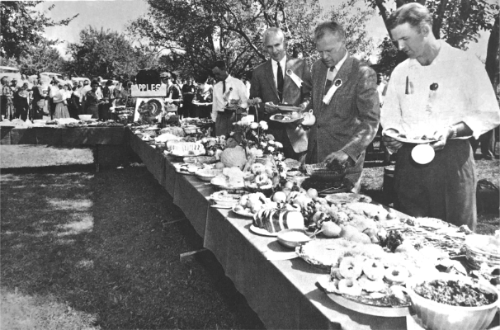
Congressman Jerry Ford at the Apple Smorgasbord
Farm wives knew apples could be used in every dish throughout the meal and it was time to share their secret recipes from salads to appetizers, main dishes, beverages, and of course desserts! The buffet featured over 200 homemade apple dishes. Small cardboard apple trays were distributed for folks to fill their plates with the many specialty recipes.
One year, Lady Bird Johnson's submission of White House Apple Tarts was the featured recipe. The women used their old German and Swedish recipes for the buffet dished. And those recipes were in high demand. In 1953 alone they received 4,237 requests for recipes. Requests from all over the country came pouring in and the growers' wives were not ready for that. The MSU extension office helped with printing and mailings and in later years an annual cookbook was presented to guests.
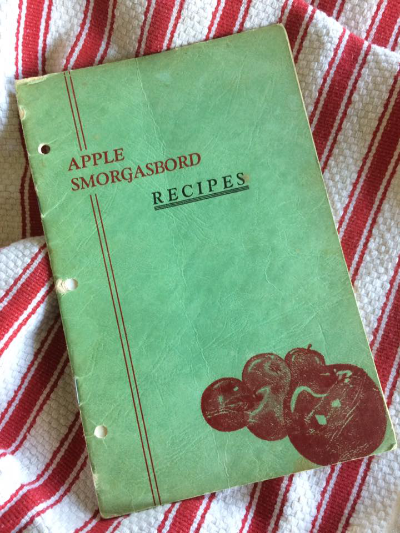
1963 Apple Smorgasbord recipe booklet from the Peach Ridge Growers Association
Apple crates were used for seating, apple boxes for tables, and there were designated apple polishers. The yearly event rotated from farm to farm and the hosting family spent many weeks grooming, cleaning, and prepping in anticipation. Future events lent themselves to themes, entertainment, and decorations to keep the event fresh.
The marketing scheme worked well as national publications and papers covered the annual celebration (Good Housekeeping, The Ford Times, Washington Post Times, and Parents Magazine). Food editors from across the U.S. would attend this unique event, but politicians came as well. It offered growers a chance to meet with public officials to discuss their concerns and likewise gave those running for office an opportunity to meet with their constituents... a win-win situation. Politicians were brought back to the basics in the farming community, and they liked to see growers take ownership for promoting their own product and not always asking for government assistance.
Planning for such an event was a yearlong undertaking with many subcommittees sharing the load. The host family had a huge commitment as did the chairman of the event. It made sense to hold this in September when the fruit was ripe of the trees and harvest was in full swing. But because of the timing, the men were in the fields so the women took the brunt of the preparation.
Past participants have two schools of thought of why the Smorgasbord ended in 1971. By the early 1970's it became evident that the chain stores were there to stay, and the small local growers were a thing of the past. Times were changing as was the attendance at the annual event. Locally owned grocers were no longer in business and representation from big chain stores like WalMart and Meijer was not happening. Food editors and buyers no longer came.
Others believed it was getting to big and hard to handle. Too many people wanted to be invited, but the number of growers in charge was the same, thus it became too much. They tried to revive the event and held two gatherings that had roots in the old smorgasbord. But that old "pa-zaz" was gone. The Smorgasbord had served its original mission, to promote the apple industry and build community among the growers. The 1971 Smorgasbord was the last one held by the Peach Ridge Growers Association.
Dairy
Through the Years
by Joanne VanderWerff
In 1917 the Carnation Milk Company opened a plant in Sparta, Michigan, conveniently located at the railroad near the corner of East Gardner and Prospect. At the time local dairy farmers supplied the milk, most likely milking only a few cows by hand, producing canned evaporated milk.
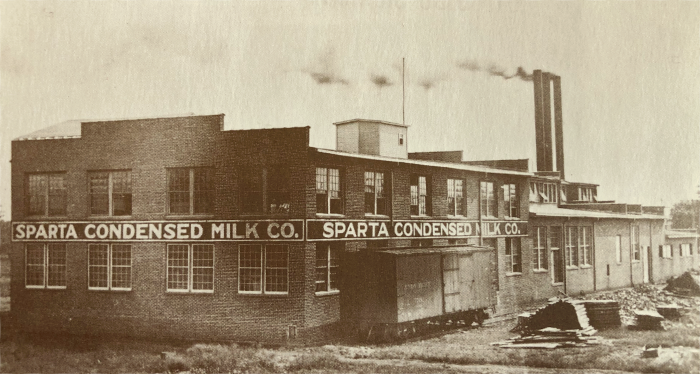
Carnation Milk Company plant
Over the years Carnation Milk Company employed a great number of Sparta residents, many of them women. By 1960 with fewer local milk producers to supply the milk, Carnation Milk Company in Sparta had no choice but to cease operations.
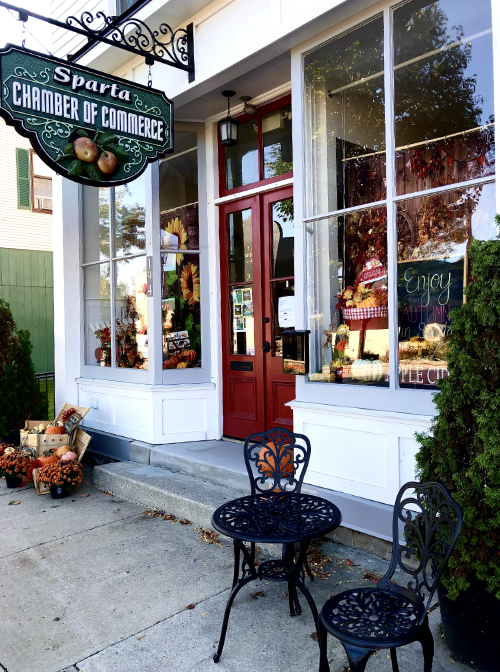
Originally Henry DeLange's Harness Shop, the building, built in 1885, now serves as offices for the Sparta Chamber of Commerce
Sparta's own Arzie Pinkney, in his "I Remember" article wrote of Sparta’s first milkman, Mr. Tuxbury. The cost of milk at the time was 3 cents a quart. Delivery was two times a week as most families in town owned their own cow. Years later he sold the business to Charlie Purdy and by then milk sold for 5 cents a quart.
Arzie also writes "Henry DeLang’s mother owned a cow she kept in a barn behind the Harness Shop." Today the newly restored harness shop is home to Sparta's Chamber of Commerce.
"In 1920 a man named Warner Siegel from Howard City started a milk business in the creamery. Many of you might remember the brick building along Nash Creek on the corner of North Union and Olmstead," wrote Arzie. "He also made butter, ice cream and installed the first pasteurizing equipment in town. Eventually the business was owned by Mr. and Mrs. Clarence Moody." The Moodys later relocated to 34 Maple Street, then Elm Street. In 1954 the business was sold to Bajema Dairy in Comstock Park who continued to deliver milk under the name of Sparta Dairy.
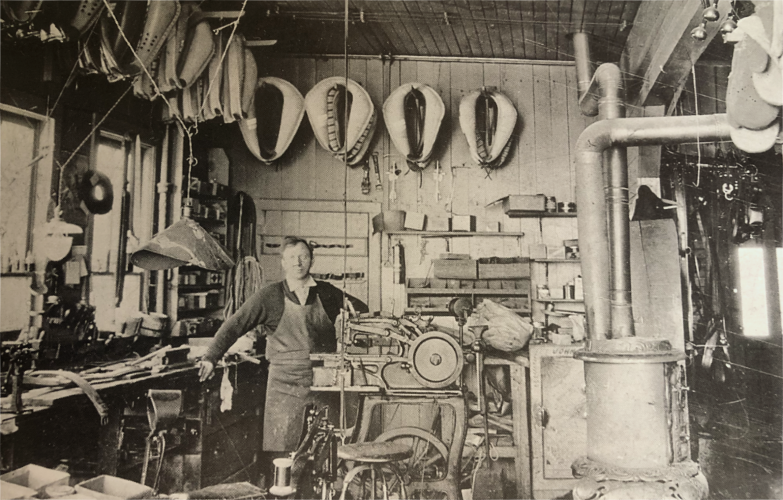
DeLange Harness Shop
Some may remember Sam Stout's Dairy on 10 Mile Road. At one time Sam most likely delivered milk to most everyone in the Sparta area. Sam was my grandma's milkman; I remember the quart glass bottles of milk delivered to her back door. The house and barns still stand today, not as a dairy farm but as Briar Barns, a beautiful wedding venue.
By the late 1930's a new dairy opened in Sparta, located in what we now know as Sparta Optometry on North Union Street. Vaughn Dairy was owned by Harold Vaughn and operated by his son Leonard. Vaughn's own dairy farm, located on Sparta Avenue just north of the city limits, supplied the milk. By now milking machines had been implemented and cows were no longer milked by hand. In March of 1941, Vaughn Dairy was sold to Floyd Buege and Lester Tanner becoming B&T Dairy Bar, a popular place for young folks to gather for a burger or soda. Vaughn's dairy farm continued to supply milk for B&T Dairy Bar.
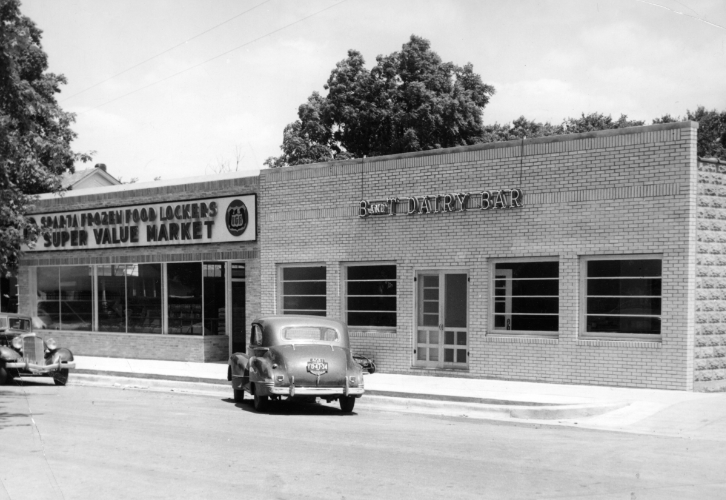
Floyd Buege and Lester Tanner's B & T Dairy Bar on North Union Street
According to an article published in the January 12, 1966 issue of the Sentinel Leader, "House of Flavors, Inc., a chain of ice cream stores, has bought the Buena Vista Dairy located at 73 ½ North Union Street, Sparta." The article states the store will continue to operate as in the past with old style ice cream. Managing the store was Mrs. Millard Belcher of Sparta. As kids we always referred to the House of Flavors as the Malt Shop. Occasionally our mom provided written permission to our teacher to walk from school on North Union Street to the House of Flavors for lunch. Seventy-five cents bought us a burger, fries and a malt. Today, the Sparta Township Historical Commission's research center is located in the House of Flavors building though for whatever reason, the address is now 71 N. Union Street.
For many of us, when we think of dairy, we think of dairy farms. Over the years Sparta has had a major role in dairy production in a way only a small town can through our small locally owned dairies, creameries, and home delivery. Not only were our local farmers responsible for providing dairy within our community, they supplied milk for a major industry which also employed many local residents.
Throughout the years dairy farming has evolved from milking by hand to today's modern, large farms with automated milking equipment. From delivering milk in large cans by horse and wagon, to delivering milk by tanker truck to large milk processors. Dairy Farms continue to operate in the Sparta area, some multi-generational such as Bradford Dairy and VanderHyde's Spartan Farms, who also provide beef to a local restaurant. Today's farmers continue to safely provide the world with an abundance of food and we can be proud of our contribution from here on "The Ridge".
Sparta... A Great Place to Grow.
Sparta Trivia
In Sparta in 1960, Luke Arends discovered a seedling near his McIntosh orchard bearing an early ripening apple that was pleasantly tart. He named the fruit Paula Red for his wife, Pauline. This Michigander apple grows throughout Michigan and continues to be one of the first to be picked in the harvest season. It is enjoyed fresh, as a sauce and in pie.--from Michigan Apples: History & Tradition by Sharon Kegerris
Contact
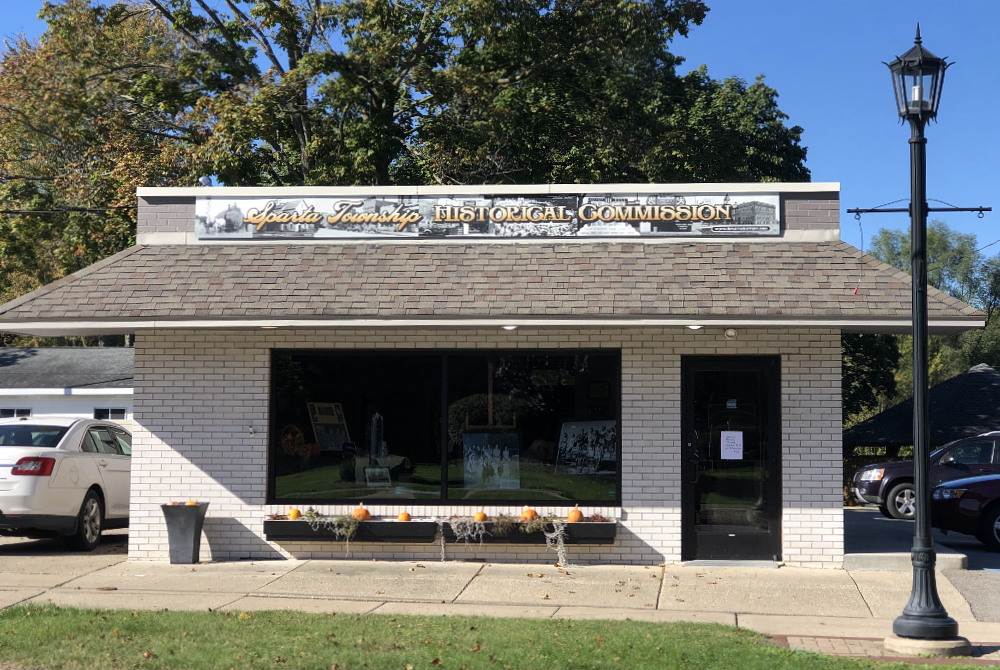
Sparta Township Historical Commission headquarters at 71 North Union Street
Our History Center is conveniently located at 71 North Union Street in downtown Sparta. Please join us for coffee and lively conversation on Monday mornings. Visits to the History Center can also be scheduled by appointment, for your convenience.
We do not receive mail at the History Center, instead, please use our mailing address, which is:
attn: Sparta Township Historical Commission
Sparta Township
160 E. Division St.
Sparta MI 49345
Our complete archives are now available online for your convenience. Just click STHC PastPerfect Catalog Access and begin your research!
For other inquiries, the Sparta Township Historical Commission can be reached by phone at: (616)606-0765 or via email at the following address:
